10 Examples of Patient Confidentiality (Exceptions Included)
There are steps healthcare providers take to better prevent the unintentional disclosure of PHI. All of those steps stem from the same source, patient confidentiality. So how do you place better protections? Well, the best way to start is by seeing some examples of patient confidentiality for yourself.

There are steps healthcare providers take to better prevent the unintentional disclosure of protected health information (PHI). All of those steps stem from the same source, patient confidentiality. So how do you place better protections? Well, the best way to start is by seeing some examples of patient confidentiality for yourself.
The Health Insurance Portability and Accountability Act or HIPAA rule is a federal law that establishes requirements surrounding healthcare records, patient records and confidentiality. It also defines the moral and legal obligations healthcare professionals must follow to comply with HIPAA privacy and security standards and prevent unauthorized access to patient information regarding patient confidentiality.
Patient confidentiality refers to the right patients have to keep their personal and medical information private. Under the HIPAA rule,healthcare providers must give patients a notice of privacy practices explaining how their healthcare data and information regarding their physical or mental health are protected. A patient must also understand these rights to ensure their own information stays secure. A healthcare provider may only share patient information when it is required by law or directly involved in patients care to maintain confidentiality without authorization.
Patient privacy is even included within the Hippocratic Oath.
Despite all of this, though, a breach of patient confidentiality occurs every 62.5 hours. That’s equivalent to a HIPAA violation occurring about every 2.5 days.
Anyone who works in the healthcare industry knows that they should avoid HIPAA violations at all costs. It usually leads to large fines and can sometimes involve jail time. At a minimum, employee discipline is certainly one potential consequence of violating HIPAA.

How could breaches in confidentiality branches occur so often? How does no one realize it?
The reality is that it’s hard to maintain patient privacy. We’re curious creatures who are nosey and like to eavesdrop and gossip, common privacy concerns in busy medical settings. The use or disclosure of information without proper safeguards can easily expose the privacy of personal healthcare data.
The reality is that it’s hard to maintain patient privacy. We’re curious creatures who are nosey and like to eavesdrop and gossip. Not to mention the bustling environment at some facilities, the high patient traffic sometimes leads to wandering eyes.
There are steps healthcare providers take to better prevent the unintentional disclosure of PHI. All of those steps stem from the same source, patient confidentiality.
So how do you place better protections? Well, the best way to start is by seeing some examples of patient confidentiality for yourself.
What is Patient Confidentiality and Why Do Healthcare Professionals Have a Legal and Ethical Duty to Protect It?
Patient confidentiality is the obligation of healthcare providers to keep a patient’s personal and medical information private. It means that any details shared by a patient, whether it’s about their health,treatment, or identity must be protected from unauthorized access or disclosure.
This principle is a cornerstone of medical ethics and is enforced by laws like HIPAA, which outlines how and when information can be shared, under what circumstances the law allows healthcare providers to disclose information. It’s also tied to the trust patients place on their providers. When patients feel confident that their privacy is respected, they’re more likely to seek care, be honest about their symptoms, and follow through with a treatment plan.
Confidentiality isn't just a rule, it is essential for quality care, strong patient relationships, and legal compliance.
How Can Breaches of Patient Confidentiality Occur and When Might Healthcare Professionals Disclose Information?
There are many ways doctors and healthcare practices can protect patient privacy.
Believe it or not, the design and layout of your waiting rooms matters. Patients who’ve already checked in shouldn’t be able to view the names and other sensitive information of patients at the front desk. The layout of reception and the position of the chairs are important factors.
Below are some examples of techniques healthcare practices use to protect the privacy oath they have with their patients.
Scenario 1: Patient Check-In
Many practices have patients sign in when they enter the waiting room. Sometimes, there will be lots of blacked-out lines above where they sign from previous appointments throughout the day.
Other times, a patient will sign on whiteboard or stickers on the front desk that get erased or removed shortly after signing.

Why do healthcare practices have patients sign their names on removable mediums?
It’s all about patient confidentiality and keeping information out of eyesight. Covered entities need to remove the names and signatures of their patients from public view to protect their privacy.
Let’s say you sign in to see a psychologist. Let’s also say your coworker sees the same therapist and notices your name on the sign in sheet. That coworker could reveal to colleagues that you’re seeking help from a behavioral health professional.
In this fictitious scenario, negligence from the healthcare entity caused a breach in privacy. By blotting out the names or removing them from the list, healthcare providers can better protect their clients. This ensures that information should be disclosed only when appropriate and that sensitive information only on official documents is visible, minimizing the risk of public exposure.
Scenario 2: Voicemail Messages
Many practices need to leave a HIPAA-compliant voicemail on patients’ phones, following the HIPAA security rule to ensure that they do not actually disclose information about a patient. Voicemails help inform clients of upcoming appointments or that their test results are ready.
Many practices need to leave a HIPAA-compliant voicemail on patients’ phones. Voicemails help inform clients of upcoming appointments or that their test results are ready.
But, if the wrong person hears the voicemail, this could lead to a breach of confidentiality. Due to that risk, medical professionals usually keep their message vague. They mention the patient’s name, the doctor’s name and the name of the practice, and a call back number.
They don’t include appointment dates or times or specifics regarding procedures or tests conducted, or any other sensitive information about a patient.
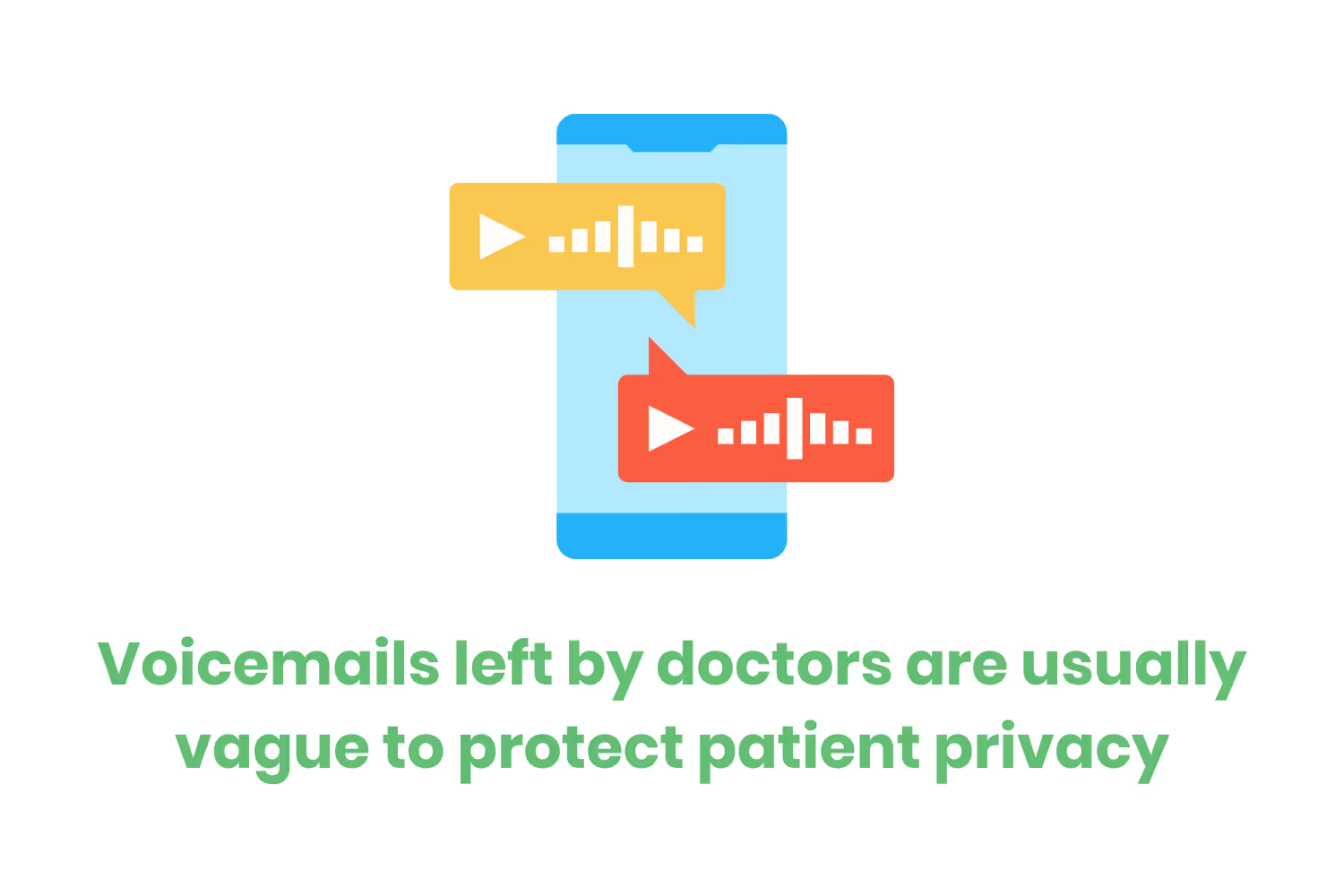
They don’t include appointment dates or times or specifics regarding procedures or tests conducted.
Including as little identifying information as possible on a patient voicemail decreases further decreases the risks associated with patient confidentiality.
Scenario 3: Lobby Privacy Windows
Do you remember earlier when I mentioned waiting room design?
I’ve already mentioned one physical protection your organization should include with blotting out and/or erasing names on your appointment sign-in sheet. But physical protections don’t end there.
Your front office staff likely makes and receives a lot of phone calls from patients (remember that whole section about voicemails?). Some of the calls that those staff members make have to include some private information by nature. How do you protect who those staff members are calling from those that are waiting for their appointment?
Privacy glass.

Privacy glass surrounding the main desk is another step that your practice could take to enhance your patients' protections. I know what you’re thinking, “Won’t these hinder my patient’s experience? It’s hard to interact with patients on a personal level through a window.”
They swivel open and close. That way your staff can still have conversations with your clients and close it to reduce the risk of eavesdropping during private calls. Privacy glass can help maintain confidentiality while allowing your team to continue providing high-quality patient care.
Scenario 4: Disposal of Documents
Some practices still heavily rely on paper documents. How many? 86% of healthcare organizations use some form of electronic health record system (EHR). Based on that statistic, 24% still spend hours printing out PHI and filing it away.
Unfortunately, if these files aren’t disposed of securely, the sensitive information could fall into the hands of malicious individuals. Not to mention the risk associated with leaving sensitive documents on desks.
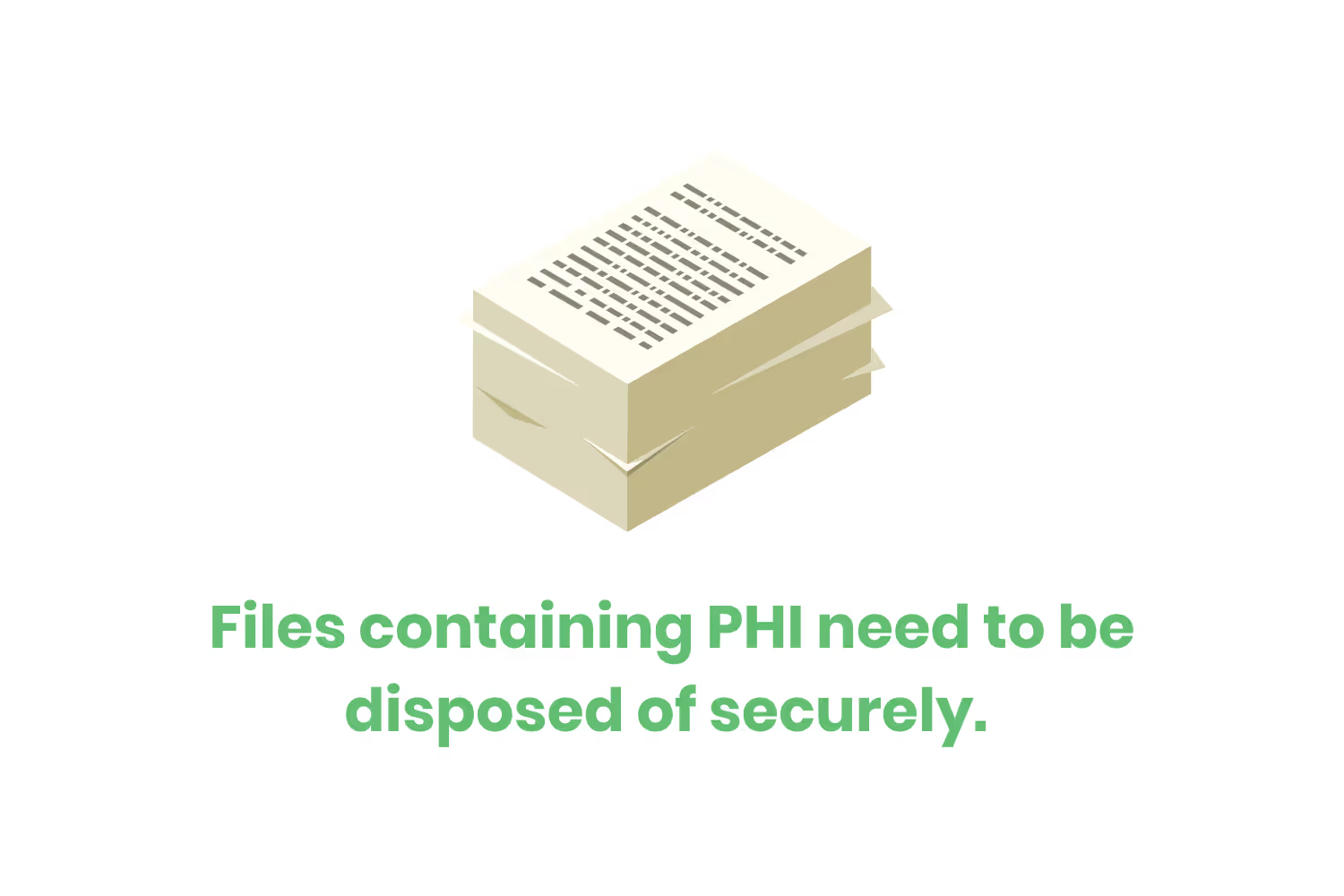
Disposing of paper patient data starts with shredding. But, having a few large shredding containers lead to stacks of "to shred'' piles across the office (risk alert). Piles of sensitive information isn’t what you want. Aside from the blatant risk of someone walking up and stealing each pile, they also open up the door to accidental disposal in your general trash (another risk alert).
The solution? Shredding containers. Placing these throughout your facility ensures better accessibility to employees, while cutting down on the risk associated with missorting sensitive documents in the general trash.
The best solution?
Switch from paper altogether.
Scenario 5: Patient Visitors
Healthcare providers need to take caution when discussing PHI in front of visitors.
For example, a doctor could accidentally disclose private information in front of a patient’s visitors. Not a big deal…unless of course the patient didn’t want the people visiting them to know those details.
How do you navigate this scenario? Consent. Always obtain consent from the patient before you disclose information about a patient to anyone else. This is an important part of being responsible for patient well-being and ensuring compliance regarding privacy standards.
Simply alert patients when they’re about to discuss PHI. This gives the patient a chance to excuse visitors from the room, especially if the patient might prefer their privacy in those discussions.
Patient consent is a good business practice many healthcare providers have to prevent a lawsuit.
What Are the Exceptions to Patient Confidentiality?
According to the American Academy of Family Physicians (AAFP), there are four exceptions to patient confidentiality.
First, a medical-care provider can disclose PHI to another physician. This can only happen when one doctor needs to ask another if the doctor needs advice on the treatment process. Otherwise, patients have the right to keep their records private unless disclosure is legally necessary.
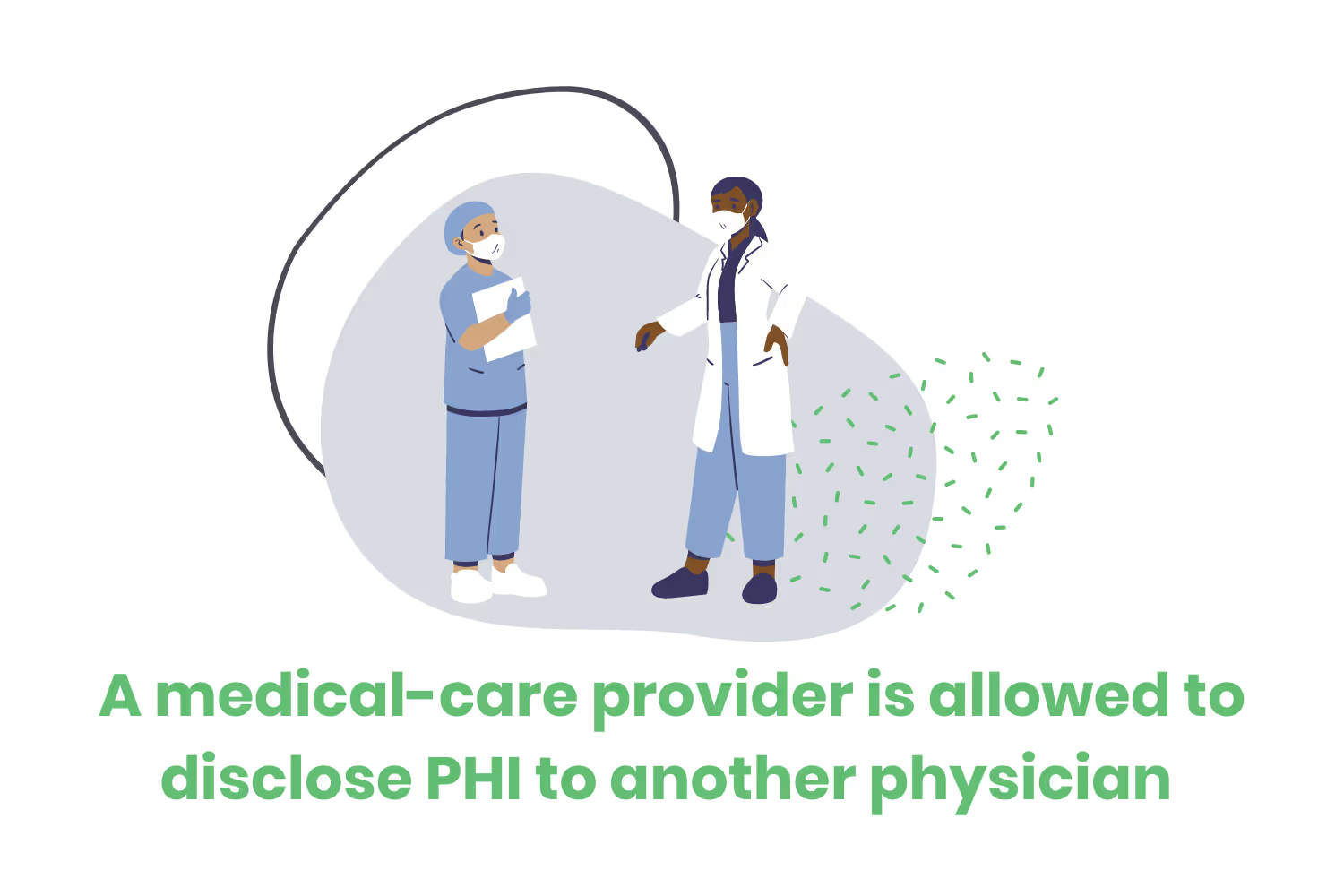
Second, if there’s a compelling circumstance that affects the patient’s health and safety, such as an emergency.
Third, sometimes a court order or statute requires reporting of a specific diagnosis to a public health authority. This usually happens because of a trial or a police investigation.
Similarly, a court order or statute may require a doctor to release a medical record to law enforcement or another legal entity. These are probably issued for similar reasons to the situation above.
There are a few other reasons not outlined by the AAFP. The governing body who determines the scenarios of when it’s permissible to discuss PHI is the Department of Health and Human Services (HHS).
The other scenarios it included are…
- Scenarios of abuse, negligence and domestic violence
- Determinations of cause of death
- Organ donation
- Research that’s designed to contribute to generalizable knowledge
- Essential government functions like national security activities
- Workers compensation law
- Limited data set
Scenario 1: Wanting to Harm Someone
Many patients who regularly see a psychologist, therapist, or psychiatrist suffer from behavioral ailments. Many patients who regularly see a psychologist, therapist, or psychiatrist suffer from behavioral medical conditions. Some experience seemingly random outbursts of rage and anger. Other people are more methodical and calculated with their emotions and actions.
If a patient reveals that they intend to harm someone, their mental health professional can legally disclose information about their patient to protect the individual in danger.
The mental health professional legally needs to protect the public from a valid, perceived threat.
Scenario 2 Child Abuse
If a healthcare provider finds concerning marks, bruises, or injuries, they’re legally obliged to contact the authorities. If a child’s well-being is in danger, a healthcare professional needs to breach patient confidentiality to protect the patient.
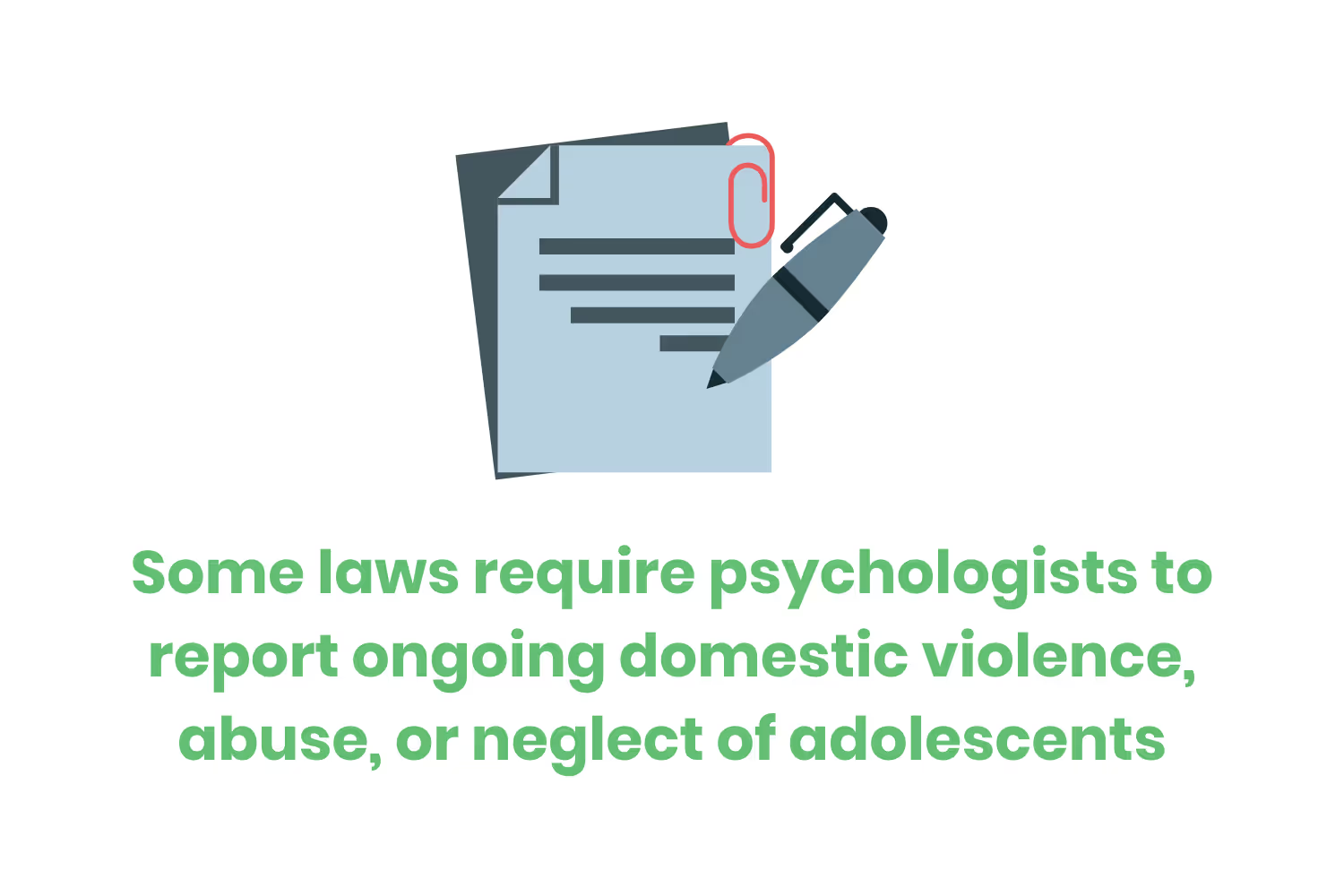
This could mean that the doctor calls child protective services and/or the police. According to the American Psychological Association (APA), some laws require psychologists to report ongoing domestic violence, abuse, or neglect of adolescents. The association doesn’t specify how the doctor should report the information or to who.
The APA goes on to explain that if an adult discloses that they endured abuse as a child, the healthcare professional is not bound to report abuse. However, if there’s abuse currently going on by the same perpetrator, healthcare professionals have to report the abuse.
Scenario 3: Second Opinions
Doctors have the right to breach patient confidentiality for clinical purposes. This means that doctors may discuss a diagnosis with colleagues if the disclosure is necessary for treatment.
When doctors need to share PHI amongst each other, they need to follow the Minimum Necessary Standard. This means that a healthcare professional may only share PHI to the least amount possible.
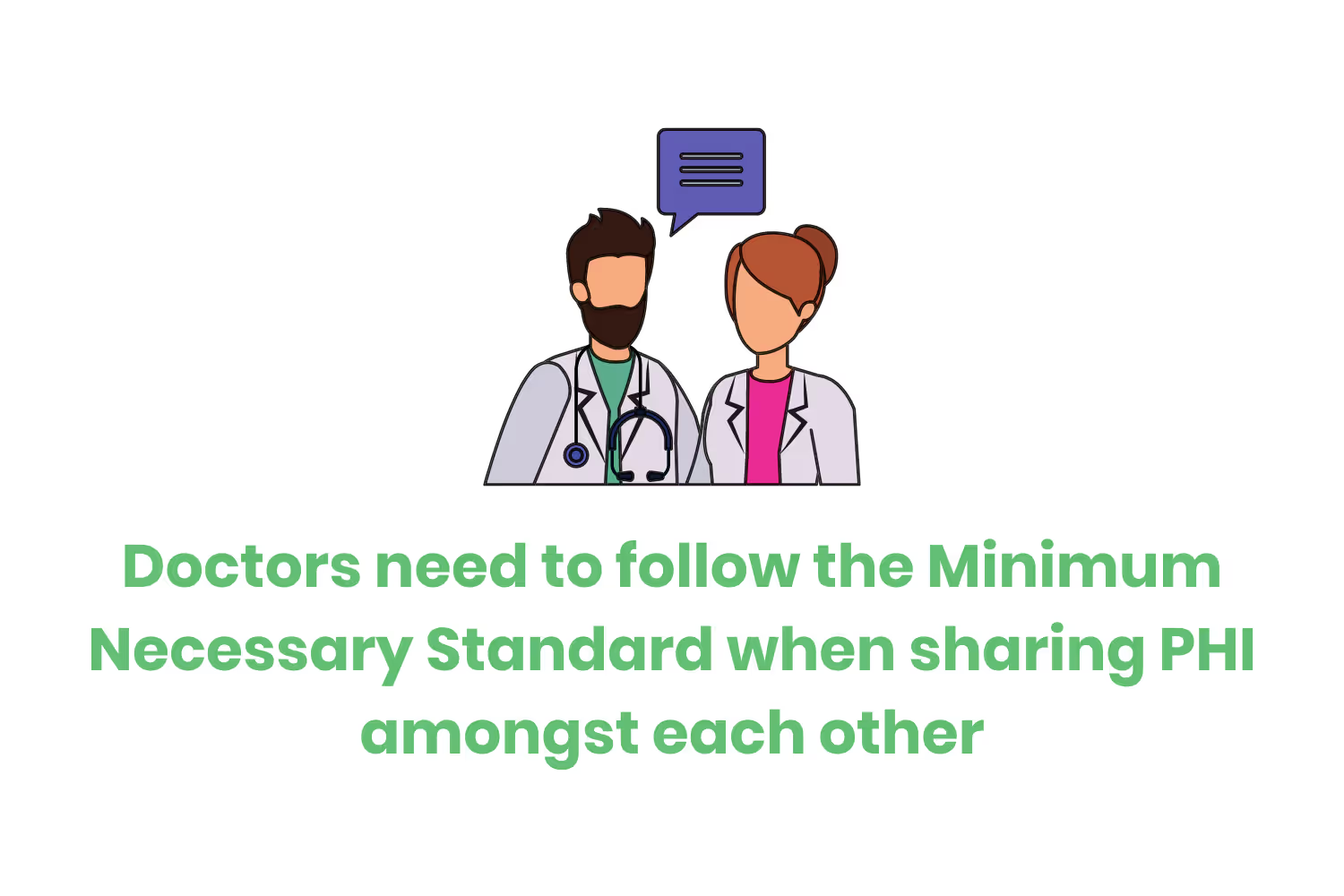
Healthcare professionals are also allowed to share confidential information if they are referring the patient to another practice or when speaking with a pharmacist. These disclosures are necessary for the successful treatment of a patient. Therefore, they’re legally permissible.
Scenario 4: Public Health Crisis
Healthcare professionals can disclose PHI, to the least amount necessary, if the disclosure can protect the general public from a health crisis.
What does this mean?
If someone in the hospital has a contagious disease that can have lasting side effects or a concerning mortality rate, the healthcare entity needs to tell the public about the situation. Any and every patient, visitor, and staff member could contract the disease, exposing more people in the public and at home.
According to the HHS, the HIPAA Privacy Rule recognizes that sometimes public health authorities and others responsible for ensuring public health and safety need to access PHI. The information helps other healthcare professionals protect their patients from the crisis at hand.
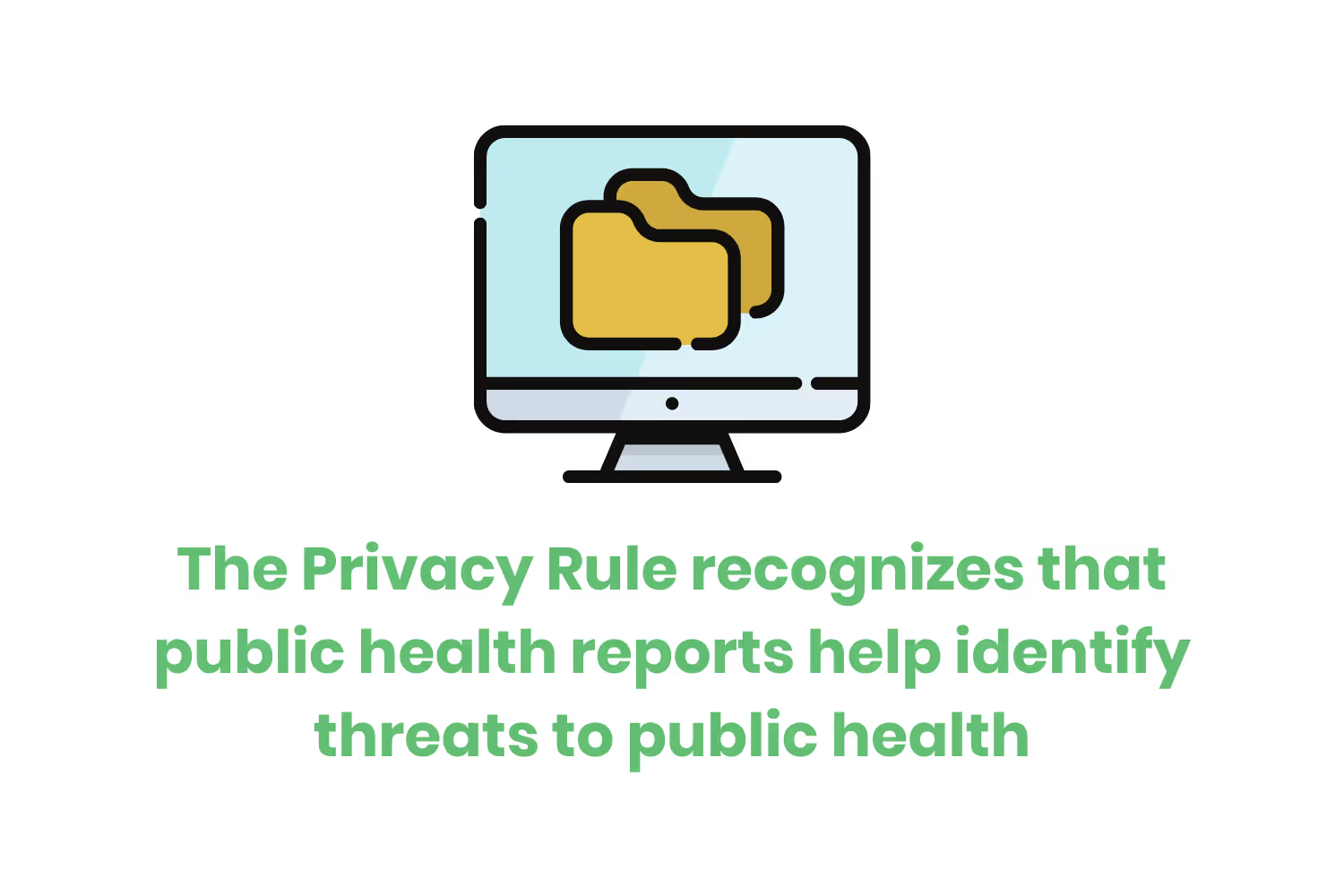
The Privacy Rule also recognizes that the public health reports made by covered entities help identify threats to public health.
Now, this doesn’t mean that doctors can declare that you are the one who contaminated everyone with an infectious disease. Nor do healthcare entities have the ability to disclose non-relevant information about you. In a public health crisis, doctors are only allowed to disclose information that can help protect the greater population.
Scenario 5: Elderly Neglect
Psychologists have the right to disclose information without the patient's consent to protect the patient.
This could mean that doctors share information with the family of elderly patients so that they can get the proper care.
Similarly, if a doctor determines that an elderly patient is enduring neglect, the healthcare professional may breach patient confidentiality. If the neglect is pervasive enough, the perpetrators could face a criminal trial. Therefore, a healthcare professional needs to disclose health information when elderly neglect is at hand.
Conclusion
There are plenty of safeguards and policies covered entities take to protect patient confidentiality. It can be a challenge for healthcare workers to remember all of these practices while actively treating patients.
One of the best ways to protect patient confidentiality is through training on HIPAA regulations and strong privacy practices. Such training reinforces how confidentiality may be compromised without proper awareness and safeguards in place. If employees take regular HIPAA-related training courses, your staff are more likely to remember and comply with confidentiality policies.
For example, if healthcare staff take training about preventing employee gossip, the employees are less likely to engage in that behavior. This, in turn, helps protect patient confidentiality.
Emphasize your product's unique features or benefits to differentiate it from competitors
In nec dictum adipiscing pharetra enim etiam scelerisque dolor purus ipsum egestas cursus vulputate arcu egestas ut eu sed mollis consectetur mattis pharetra curabitur et maecenas in mattis fames consectetur ipsum quis risus mauris aliquam ornare nisl purus at ipsum nulla accumsan consectetur vestibulum suspendisse aliquam condimentum scelerisque lacinia pellentesque vestibulum condimentum turpis ligula pharetra dictum sapien facilisis sapien at sagittis et cursus congue.
- Pharetra curabitur et maecenas in mattis fames consectetur ipsum quis risus.
- Justo urna nisi auctor consequat consectetur dolor lectus blandit.
- Eget egestas volutpat lacinia vestibulum vitae mattis hendrerit.
- Ornare elit odio tellus orci bibendum dictum id sem congue enim amet diam.
Incorporate statistics or specific numbers to highlight the effectiveness or popularity of your offering
Convallis pellentesque ullamcorper sapien sed tristique fermentum proin amet quam tincidunt feugiat vitae neque quisque odio ut pellentesque ac mauris eget lectus. Pretium arcu turpis lacus sapien sit at eu sapien duis magna nunc nibh nam non ut nibh ultrices ultrices elementum egestas enim nisl sed cursus pellentesque sit dignissim enim euismod sit et convallis sed pelis viverra quam at nisl sit pharetra enim nisl nec vestibulum posuere in volutpat sed blandit neque risus.
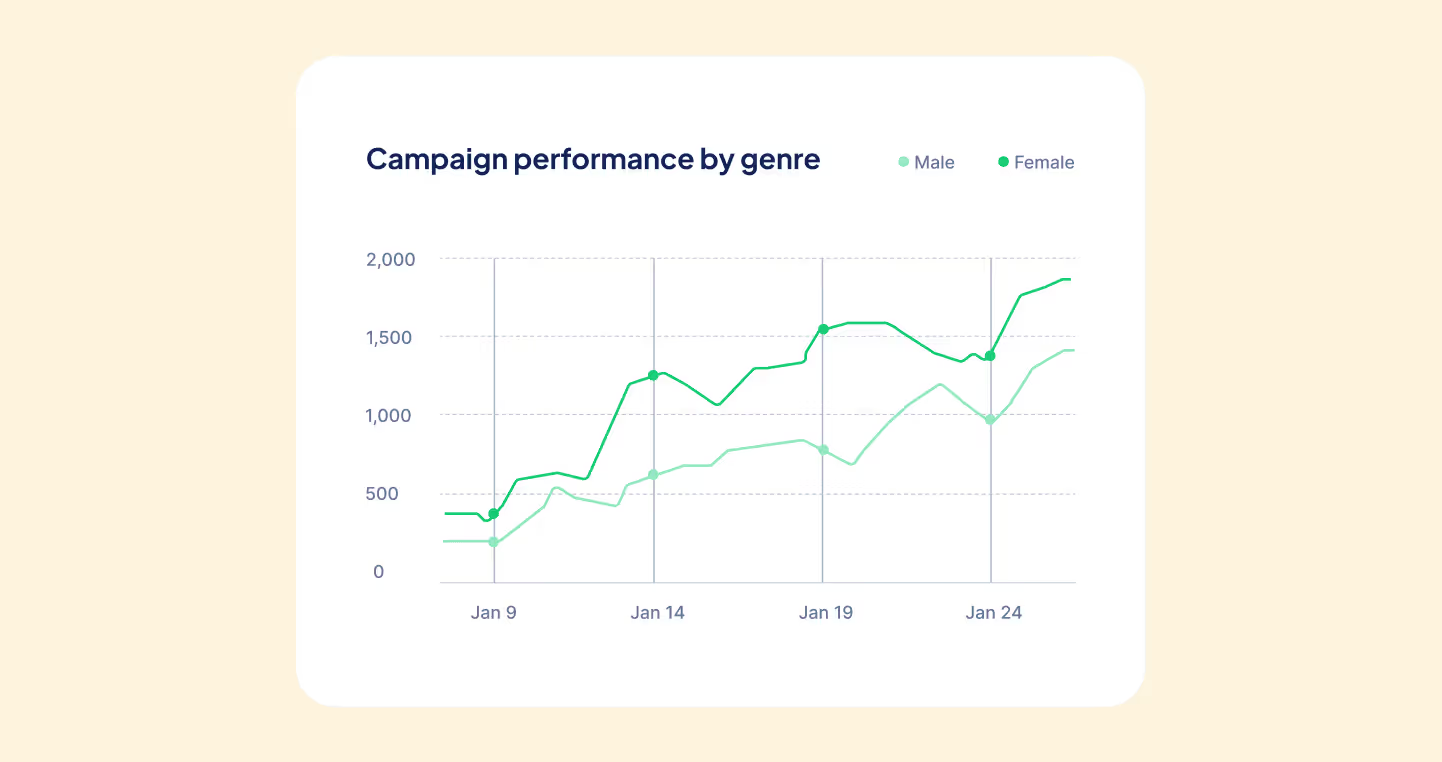
Use time-sensitive language to encourage immediate action, such as "Limited Time Offer
Feugiat vitae neque quisque odio ut pellentesque ac mauris eget lectus. Pretium arcu turpis lacus sapien sit at eu sapien duis magna nunc nibh nam non ut nibh ultrices ultrices elementum egestas enim nisl sed cursus pellentesque sit dignissim enim euismod sit et convallis sed pelis viverra quam at nisl sit pharetra enim nisl nec vestibulum posuere in volutpat sed blandit neque risus.
- Pharetra curabitur et maecenas in mattis fames consectetur ipsum quis risus.
- Justo urna nisi auctor consequat consectetur dolor lectus blandit.
- Eget egestas volutpat lacinia vestibulum vitae mattis hendrerit.
- Ornare elit odio tellus orci bibendum dictum id sem congue enim amet diam.
Address customer pain points directly by showing how your product solves their problems
Feugiat vitae neque quisque odio ut pellentesque ac mauris eget lectus. Pretium arcu turpis lacus sapien sit at eu sapien duis magna nunc nibh nam non ut nibh ultrices ultrices elementum egestas enim nisl sed cursus pellentesque sit dignissim enim euismod sit et convallis sed pelis viverra quam at nisl sit pharetra enim nisl nec vestibulum posuere in volutpat sed blandit neque risus.
Vel etiam vel amet aenean eget in habitasse nunc duis tellus sem turpis risus aliquam ac volutpat tellus eu faucibus ullamcorper.
Tailor titles to your ideal customer segment using phrases like "Designed for Busy Professionals
Sed pretium id nibh id sit felis vitae volutpat volutpat adipiscing at sodales neque lectus mi phasellus commodo at elit suspendisse ornare faucibus lectus purus viverra in nec aliquet commodo et sed sed nisi tempor mi pellentesque arcu viverra pretium duis enim vulputate dignissim etiam ultrices vitae neque urna proin nibh diam turpis augue lacus.




